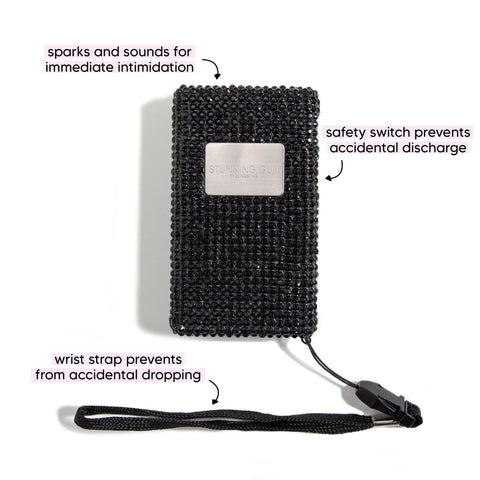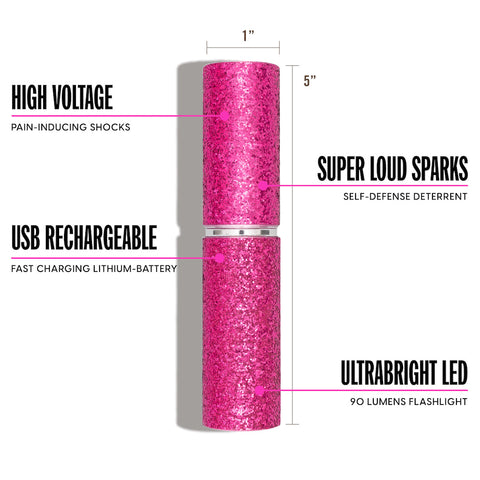What are the Effects of a Stun Gun?
Feeling safe is important to everyone. Stun guns and Tasers are tools people use for protection. This article will show you what happens when someone uses a stun gun on another person.
Keep reading to learn more!
Table of Contents
- Overview of Stun Guns
- Design and Operation
- Legal and Ethical Considerations
- Physical Repercussions of Stun Gun Deployment
An Overview
- Stun guns and Tasers can cause pain, muscle spasms, and make it hard to move by sending electric shocks.
- Getting hit may leave marks on your skin or hurt inside your body, like causing heart trouble.
- Being shocked affects the brain too; making it tough to think or remember things right and can lead to feeling really scared or sad later.
Overview of Stun Guns
Stun guns work by shooting electrical shocks into the body to cause pain and muscle spasms, resulting in unsupported falls, stopping an assailant in a non-lethal manner. Other effects could include cognitive disruption/disorientation, skin trauma, and in rare cases cardiovascular issues such as arrhythmias.
Design and Operation
Stun guns pack a punch with high voltage discharge to mess with the heart's beat.
With the push of a button, these gadgets send out electricity that makes muscles go wild and leave baddies in pain and confusion.
The current zings through the attacker, causing muscle madness and dropping them like hot potatoes.
Tasers are another type of electroshock weapon that shoots out two darts attached to wires. When they hit someone, they deliver powerful electrical shocks right into their muscles.
This shock is no small tickle—it ramps up muscle activity until moving is not an option.
Legal and Ethical Considerations
People have many thoughts about stun guns and tasers. They talk a lot about if it's right or wrong for police to use them. Some say these tools help because they are not as deadly as guns.
But others worry. They think about the harm they can do, especially to people who are very heavy or on certain drugs. There's a big push to keep an eye on how stun guns affect folks.
This is so important that groups are studying and talking about it all the time.
Laws around these tools differ from place to place. In some spots, you can't have them at all. Others let you carry one with rules in place. The goal is always safe streets but figuring out the best way isn't easy.
Making sure everyone knows the law helps keep things clear for both officers and everyday people.
Physical Repercussions of Stun Gun Deployment
When a stun gun hits someone, their muscles lock up tight. This can hurt the skin and even go deeper, affecting what's inside.
Induced Muscle Spasms
Stun guns send high-voltage electricity to make muscles twitch hard. This can make someone fall or get hurt because they can't control their body. The power from the stun gun messes with the nervous system, making it hard for muscles to work right and causing lots of muscle contractions.
It's like forcing your body to run a marathon without moving from one spot.
Stun devices shock you into a standstill, taking over your ability to move freely.

Using stun guns in probe mode shoots tiny barbed darts that stick and then shock you, leading to these strong spasms. While TASERs zap you into not being able to move by making your muscles squeeze tightly, they don't seem to damage muscle cells too much.
Yet, the forced squeezing from electric shocks could still lead to falls or broken bones just like serious sports injuries.
Skin Trauma and Internal Effects
A stun gun hit can leave marks on the skin. These might be small burn spots or tiny holes where the metal touched you. Such injuries happen because of the heat and force from the electric shock.
Inside your body, things can get rough too. The shock doesn't just dance on your skin; it dives deep, causing muscle damage that's not easy to see right away.
Muscles work hard during a shock. They might pull or strain in ways they're not supposed to, leading to more than just a day of soreness—think tears or severe strains that need time and care to heal.
More scary stuff can happen inside like messed-up heart rhythms or even burns inside where we can’t see them without medical help. It’s intense what an electric burst does beyond hurting at first touch.
Cardiovascular Responses
Moving from skin and internal issues, stun guns impact the heart too. Studies once showed these weapons were safe for the heart. Yet, recent research tells a different story. A related product, the TASER X26, a popular model, can indeed lead to cardiac arrest.
This is scary because it means the electric shock messes with the normal rhythm of your heart. It can push it into a state called ventricular fibrillation.
This is when the heart quivers instead of pumping blood properly. People have even died from such problems after being hit by a stun gun. So, using these guns is not as risk-free as some thought before.

They do more than just cause pain or make muscles spasm; they can seriously harm how your body's most important muscle works – without warning.
Psychological Aftereffects of Experiencing Stun Gun Shocks
Feeling a stun gun shock can mess with the mind. People might forget things or feel very scared long after the shock happens.
Cognitive Disruption and Memory Loss
Stun gun shocks can mess with the mind. Research shows that people shocked with 50,000 volts from a stun gun can't think as well or remember things like they used to. This happens because the shock affects how the brain works.
Imagine trying to remember something important, but you just can't. That's what it feels like.
Some studies even found that getting shocked by a stun gun is like suddenly getting much older in your head. People might forget where they are or have trouble learning new things for a while.
It's scary stuff, and it shows how serious being tased can be for the brain and memories.
Emotional Aftermath and Stress Response
After learning how a stun gun shock can mess with the brain, it's clear there's more to worry about. Getting hit by a stun gun doesn't just leave physical marks; it also does a number on your feelings and mind.
People often feel scared, alone, or really sad after being shocked. They might have nightmares or feel like they're living that scary moment all over again out of nowhere.
Dealing with these feelings isn't easy and some folks need help from professionals who understand mental hurt like therapists or counselors trained in dealing with trauma. They use talk therapy to help people work through their fear and confusion.
Finding support from family or friend groups can also make a big difference in feeling better faster. These emotional wounds can take time to heal, much like physical ones, suggesting that getting shocked by a stun gun has long-lasting effects that aren't just skin deep.
Conclusion
Stun guns and Tasers send a jolt that can stop you in your tracks. They make muscles twitch hard and hurt without causing lasting harm. Feeling the zap might scare someone, giving them bad dreams or trouble thinking clearly for a while.
Tests haven't found big health problems from these shocks later on. Yet, doctors say we should keep checking how they affect the mind and heart over time.
FAQs
1. What happens when someone gets hit by a stun gun?
While the effects of a stun gun do not cause serious injury, they are effective and will bring the attacker an extreme amount of discomfort and pain. In a nutshell, the stun gun sends a shock wave to the nervous system and essentially over works the muscles. This causes severe pain.
2. Are stun guns and tasers the same thing?
Stun guns and tasers are the same in category, they are both electrical defense weapons that send painful shocks. The difference is that stun guns work with actual physical contact to send the shock, while Tasers have projectile prongs, two small dart-like electrodes , that reach up to 15 feet or even 35 feet. The downside of tasers is that many tasers have single cartridge models, so you have to change the cartridge before firing shock, some Taser models can hold 2 cartridges. There have also been reports from experience that Tasers failed 40% of the time.
3. Can getting shocked by a stun gun be dangerous?
Getting shocked by a stun gun causes temporary incapacitation and unsupported falls which can cause fractures, but in rare cases. It can stimulate heart muscles promoting lethal cardiac arrhythmias especially those with pre-existing health conditions.
4. How long does a stun gun effect last?
The temporary incapacity of the assailant lasts for several minutes, giving sufficient time for the victim to run.
5. What is the best stun gun for a woman?
Blingsting stun guns have been made with the woman in mind as it is compact to carry, whether you choose the high-voltage stun gun which has a wrist strap to prevent dropping during the most critical emergencies, or the skinny lipstick stun gun which fits in the palm of your hand, yet it has max allowable power to inflict temporary paralysis on the attacker,

Our high-voltage stun gun helps you be safer


5. How long should you use a stun gun?
You should hold the stun gun against the assailant for 3 to 5 seconds to allow the current to flow through the assailant’s body and cause temporary incapacitation without affecting you. A short blast, or less than one second of contact, can startle the subject, cause minor muscle contractions, and have a repelling effect. A medium blast, or one to four seconds of contact, can cause the subject to fall and create mental confusion. While it may deter further aggression, the subject will be able to recover and get up immediately. A full blast, or 5 seconds or more of contact, can cause disorientation, loss of balance, falling to the ground, weakness and general confusion.
Related product:Self Defense Set
